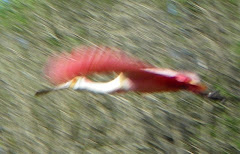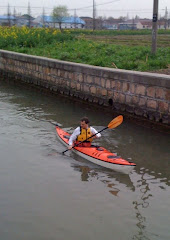From a dream I awake in Bohuslӓn in a car. Back-seat sleeping
beats back-seat driving. Sleepily I follow Felix and Axel from Point65 to join outdoor
people from all over the world for the Outdoor Academy of Sweden.
From Grebbestad we were about to float out in groups between
the islands and rocks of the Swedish west coast archipelago, paddling Point65kayaks. But first, there are several sponsors and in the building with all the kayaks are
neatly arranged piles of equipment, one for each person and some for each tent
group. We don’t need to bring much of our own: this trip will be a showcase for
Scandinavian design.
Leading my group from the beach is Christina who guides
trips in the archipelago for a living. I’m comfortable from the moment she
starts. Some of her first words explain how much she is love with the rocks.
 Bohuslӓn is a place of rock and water. The ice sheet of the last
ice age smoothed the rock surfaces, grinding them smooth as silk, and leaving
subtle curvaceous edges between undulating faces. Stones frozen into the slowly
moving ice gouged grooves across that suggest the work of a giant comb. The sea
has since added its mark on the slowly rising land, and the salt creates a border,
allowing the gradation of more or less salt-tolerant species to cling to the
faces in different colored bands. Above I see tiny flowering plants clinging to
cracks, and the lichens and mosses, trees and grasses that sometimes struggle
to make this part of Sweden their home.
Bohuslӓn is a place of rock and water. The ice sheet of the last
ice age smoothed the rock surfaces, grinding them smooth as silk, and leaving
subtle curvaceous edges between undulating faces. Stones frozen into the slowly
moving ice gouged grooves across that suggest the work of a giant comb. The sea
has since added its mark on the slowly rising land, and the salt creates a border,
allowing the gradation of more or less salt-tolerant species to cling to the
faces in different colored bands. Above I see tiny flowering plants clinging to
cracks, and the lichens and mosses, trees and grasses that sometimes struggle
to make this part of Sweden their home.
It is autumn. Already I hug my arms close and hide my
fingers from the breeze. The leaves are turning brown. Rose hips and rowan berries glow a startling
scarlet. The sun is out and the visibility is so good, we see the most distant
islands looming in mirage above the horizon. Here is a playground that begs to
be explored. We can only scratch the surface. This is just a preview.
We pass a lighthouse, tuck behind islands and between rocks.
Here and there the professional photographers hop ashore and run up the rocks
to catch the best camera angle as we pass.
We land on a tiny sand beach, just big enough for all our
kayaks. In minutes the Tentipee tents are raised like pyramids on the flat
grass. Out from the hatches come the Primus stoves and the food packs, water
bottles and wine sacks.
While some change from paddling gear into the warm and
dry layers provided by Didriksons, others fire up the stoves. Christina pulls a
Grandfors axe and a saw from somewhere deep in her Whisky16 and begins to
prepare a woodpile. She saws logs and branches into short pieces then splits
them into sticks. We’ll have a fire but we don’t need a furnace.
Then sparks fly! We each have a “Light-my-Fire” knife with
its special magnesium bar in the handle, and a stick of special wood, aromatic
with its natural oils, to peel into tinder. One stroke of the magic stick with
the back of the blade sends a cascade of sparks to the tinder, and in no time
we have fire.
Finally we all gather to eat. Christina has brought smoked
salmon for tonight, reindeer meat for tomorrow. Swedish design comes forward
again with dishware by “Light-my-Fire”. We eat with “Sporks”.
The Scandinavian Outdoor Group (S.O.G.) was created in 2000
as an industry initiative to help outdoor retailers and manufacturers in the
export market. It is a collaboration of main players in the Outdoor industry
from all five countries; Norway Sweden Finland Denmark and Iceland. Here in Bohuslӓn with the Outdoor Academy of Sweden (O.A.S.)I
have the pleasure to meet not only representatives from Scandinavian
manufacturers but also journalists, retailers and tour operators from around
the world. Around the fire my companions are Swedish and Japanese,
Korean-Swedish and French, German, English and Russian. I love it!
Some of us rise before dawn to catch the magic light of
first sunrise. While the professionals catch their digital magic I climb the
island and stroll along the top. Here is a boulder-field like a beach of
lichen-crusted heads with a rose bush heavy with red hips, and some blonde
grasses. Suddenly the first of the sunlight hits the tops of the heads with a
wine-colored glow. I’m stopped in my tracks. One moment like this is a thousand
songs. When I turn back against the sun I’m captivated by the subtle snake-path
of a slight ridge between two ice-smoothed slopes. On side one the crystals and
tiny lichens are casting shadows, while the other for the moment is just in
shadow, highlighting the curves between.
For a full day of sun we explore the islands, stopping by a
small town where small rust-colored houses cluster around a church with a
spire. Fjӓllbacka
is the setting for writer Camilla Lackberg’s crime novels. Already one of the
hottest crime writers in the world, Lackberg is likely to become even better
known soon. Later this year the first of a new collection of 10 TV movies based
on Lackberg’s books and filmed here will be released.
We weave a different route north than our way south, finally
finding our place for the night on the tiny island Kӓften, where Jean Marc beckons
me across the rock to see the last glow of fire in the sky from sunset.
I am woken by wind-driven rain against the Tentipi. It’s
still dark but O.A.S. has plans for today that mean we must launch at first
light. I fumble to pack in the dark with my tent-mates until finally I feel my
headlamp and set it glowing. Then we drop the tent and load our hatches before
breakfast. It’s rainy and windy and a struggle for the least experienced
paddlers but we arrive with smiles at Grebbestad by 9 am. Once the gear has
been sorted we all leave for the business side: meetings at a special location,
Nordens Ark.
Nordens Ark is a place dedicated to the preservation of
endangered species. Our tour is rapid due to the rain, but we see snow leopards
and white backed woodpeckers and lynx on our way to dine. It’s a very special
dining room with long windows. It’s located in the wolf compound, and the
wolves, feeling safe in their enclosure trot around right outside the window as
we eat.
It’s a fitting end to a wonderful islands experience,
because it reminds me how fragile this world we enjoy is. The wildlife is part
of the whole experience. We have seen seals and birds and with the start of
the lobster fishing season we have watched all the small boats head out to set
their pots to reap their harvest. We
have landed in places that hold no footprint and taken away photos and mental
images and friendships, yet without our care these islands would change for the
worse, and quite rapidly. The experiences and networking within our group can
only serve to help.
Satisfied we left Bohuslӓn as we found it, I know I will
return. I love this place. Thanks O.A.S!
See another perspective with the Outdoor Academy of Sweden blog














































